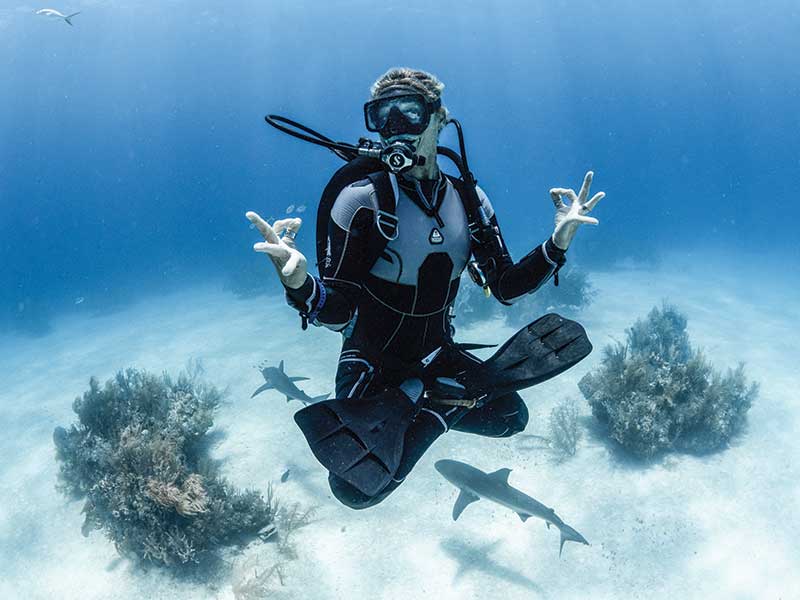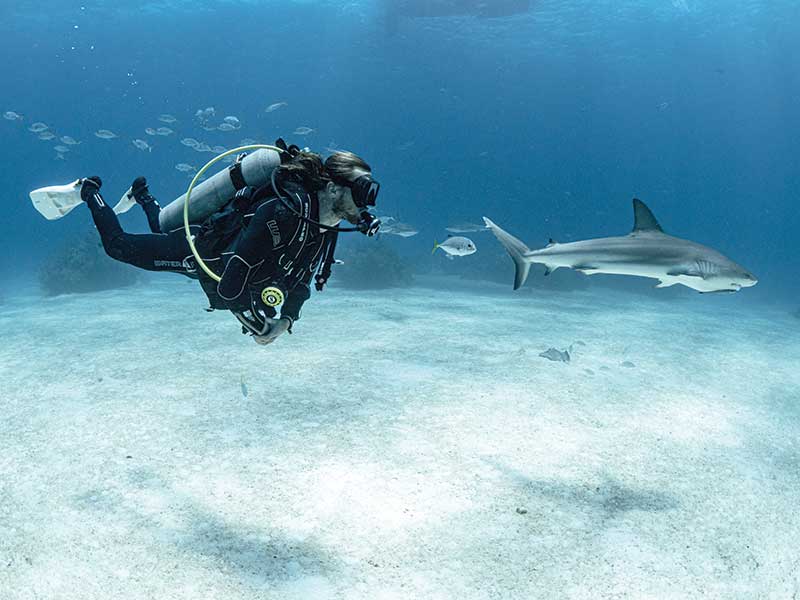Debunking Shark Myths
By Cristina Zenato

Diving with sharks is a bucket list item for many divers. The first-time shark diver may feel a mix of curiosity and trepidation, and many, as they stand at the edge of the platform before jumping in, may still have questions. In this column, I am going to touch on those concerns.
But before we dive in, I want to clarify that there are over 500 species of sharks in the world and, for the purposes of this column, I will be using the word term ‘sharks’ in a very fluid manner. I believe that one size does not fit all, and, as we address shark encounters, we should consider each species, situation, and activity.
These are some of the common concerns I have heard throughout my career:
The sharks will rush towards me as soon as I jump in
Sharks are not interested in humans, but they might be attracted by our presence or by the previous activity of others there before us. It is a myth that sharks will rush towards a diver the moment they jump into the water. The simple fact that we are wearing scuba gear sends out a message that we are an alien entity; we also need to remember there are very few species who would feed on animals our size. The moment we jump in, the sharks will scatter away, more scared of us than we of them.
Sharks are attracted by my blood or pee
While it’s true that sharks have an acute sense of smell and a sensitive olfactory system, sharks are not attracted by the smell of our blood or urine. I’ve heard nervous divers talk about Oceanic White Tips and some of the most famous wrecks in human history; the situation in those cases was very different from one healthy diver jumping in with a small cut or a period. In the case of those shipwrecks, the amount of debris and garbage from the kitchen and the toilets and the number of injured, dead, and dying people attracted the sharks to complete the role assigned by nature: clean the ocean. The ability of sharks to detect minuscule amounts of certain substances varies amongst the different species of sharks; some can determine their prey at one part per ten billion, which equates to one drop in an Olympic-size swimming pool!
Still, even with that capability, the sense of smell is not a superpower. We need to remember that the particles have to hit the animal’s nostrils; at which point the animal, like any other predator, will take into consideration ‘return on investment’.
Sharks are not mindless jaws in constant search of prays; they spend most of their time roaming the oceans like any other predator would do on land, sharing their space and only hunting when strictly necessary and with a high chance of success.
Yum-Yum Yellow
While it is true that light colours and contrast between light and dark are more attractive to sharks, wearing a bright piece of gear won’t create an instant attraction from the sharks in the area. Death underwater turns the colour of white. It is natural for predators such as sharks to investigate lighter colours, but we need to put this into perspective. When scuba diving with sharks, we send numerous signals to the animals that we are a foreign entity, from the scuba gear to the fact that we have a heartbeat and brain waves and are moving. For an animal to investigate something bright or shiny, it would most likely be associated with other possible injury or death signs.
They are attracted to nervous people
Nervous or not nervous, it won’t make a difference in the shark’s decision to approach a diver; however, an anxious person moving erratically and flailing through the water column might attract more attention by sending out a message that they are struggling. When diving with sharks, it’s always best to be comfortable with personal diving skills and avoid rapid, jerky movements that might attract interest.

Wearing a repellent device will keep sharks away from me
Throughout the years I have worked in the shark diving industry, I have seen my fair share of shark repellents. In all honesty, I have yet to see a shark repellent that works for every species in every situation. Let’s review some of the most used by divers:
The poisonous snake suit: a black and white striped suit to mimic the poisonous snake of the Pacific. It might work until you are diving with species unfamiliar with the snake or big enough not to mind its presence. Let’s not forget that many species are also attracted to the contrast and the moving shadows created between black and white.
The Mimic suit: designed to blend us into the water, is painted in different shades of blue to be absorbed into the fluid world and make us invisible. With eight senses, sharks rely not only on sight to detect prey; the fact that they might not see us at first won’t prevent sharks from locating our bubbles, movement, and other life signals.
The Electric Pulse anklets: so far, I have seen them used with small species, and while causing the animals to act a little erratically, I have not seen them working to keep them away from anyone. Furthermore, I would like to see better testing of these devices in situations using proper control groups.
The best deterrent is knowledge and an understanding of the animals we go diving with.
Sharks must keep moving to stay alive
Perhaps the biggest misconception surrounding sharks. Sharks ventilate through two different systems. All species possess a ram ventilation system; the animal swims through the water with a slightly open jaw, and the water flows through the mouth and over the gills, where they extract oxygen for survival. Most shark species possess another system called buccal pumping. While resting on the ocean floor, the animal can pump water over the gills with a gentle opening and closing of the mouth. The water will similarly flow over the gills as if in movement allowing for oxygen extraction.
Contrary to popular belief, only a few species need to move to keep ventilating continuously.
Sharks have no predators
Most sharks are apex predators within their marine ecosystem, meaning they sit at the top of the food web and have no, or very few, natural predators. The greatest threat to sharks is humans. Shark populations are in decline everywhere globally, with as many as 100 million sharks killed each year by the fishing industry. We are most likely to be hit by lightning, or killed by a falling coconut or a vending machine, than a shark.
While fear is a state of mind that has allowed us to evolve and keep alive as a species, too much fear and misunderstanding can prevent us from truly experiencing and sharing our underwater world with sharks.
Knowledge is the best weapon to use against fear. As I have mentioned before in my column, it’s always best to ask questions, understand the animals we are about to encounter, and prepare for a shark diving trip to avoid unwanted stress and anxiety. If we are in the ocean and have seen a shark, we are unlikely to have any problems; we only need to confront our fear.
Cristina Zenato is a member of the Women Divers Hall of Fame, The Explorers Club, and the Ocean Artists Society. She has been diving with sharks for the last twenty-five years and has been instrumental in pushing forward an image of sharks that shows their real nature. For more on Cristina visit: www.cristinazenato.com







